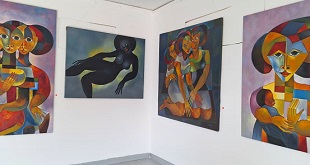
Art is not pretentious that the viewer should feel the need to go to art school to acquire a certain level of knowledge to appreciate it.
Kampala, Uganda | DOMINIC MUWANGUZI | “Don’t put money before art!” was the resounding warning by Francis Xavier Musango Gwantamu; the illustrious artist and teacher; to his students. At that time, he was wary of the growing trend in the visual arts to produce art with the primary goal to make money. Obviously, he was not against the idea of artists making a living off art, but detested the notion of putting survival before the creative process. Art involves being creative, original and authentic. It therefore demands that the artist undergoes self-reflection and discovery to produce original and authentic art that imbues the feelings and emotions of what surrounds them. With emphasis on making money, such a salient aspect can be compromised. This is because the focus is put on the monetary benefit of the art making process and not its intangible value that usually lives on for posterity.
Previously, artists like Francis Nnagenda, Theresa Musoke and Ignatius Sserulyo created emotional art that has sustained its relevance until today. Sserulyo’s sculptural figurine Old Woman 1965, standing in the compound of the Makerere Art gallery is a brilliant demonstration to the emotional art approach. The artist interrogates the subject of old age by sculpting an image of an old woman seated on the ground. The portrait depicts the effects of old age on the human body and not the simple message of physical inability. In order to realize such emotional outlook of the subject, the artist sculpts sagging breasts on the shrinking chest of the female figure, a frail body supported by the right arm almost firmly placed on the ground and a narrow wrinkled face which immediately reflect fatigue and fragility. The depiction of these physical features as weak and almost eroded is a powerful representation of the consequence of old age in the woman who is often described as the epitome of beauty. The artist therefore, implores on the viewer to not feel sympathetic of the subject, but to interpret the artwork within the framework of old age and beauty. He thus insinuates that it is possible to stay beautiful in old age. The Old woman’s beauty is captured in her dignity and self respect seen with the way she’s seated.
The manner in which this open air sculpture makes us feel is extraordinarily unique if compared to other sculptural works that are created in the present day. The Statue of Leadership standing in front of Amber House building in Kampala, is a terrible depiction of the theme of good leadership. The artist Richard Kabiito of Makerere Art School leaves many viewers guessing the context within which the monumental figurine was created. As such, it offers no hints on the subject of good leadership or visionary quality it reportedly examines. This feeling of uncertainty for the viewer perhaps suggests the vagueness of the sculpture despite its presence in public space. Both Sserulyo and Musango would have offered such scathing criticism for the lukewarm technical competence of the artist behind the work. Incidentally, the commemorative figurine was commissioned by Ministry of Energy to remember the role played by the former Buganda Katikiiro in the introduction of electricity in Buganda and later across the country.
Conversely, the Stride Monument, popularly known by its commemorative name CHOGM Monument 2007, next to parliament building, is a much better execution by artists. The figurine represents three human figures moving forward as a representation of a country going forward or on the move. The depiction of man, woman and child was appropriate to illustrate the idea of unity and togetherness that the country needs in order to realize the objective of going forward. The three figures symbolically represent the family which is an important component of the Ugandan society. Unlikely, its location frustrates the viewers’ interaction with it. In recent times, the sculptural work has totally disappeared from the Kampala public art landscape because of the ongoing construction in the area. Will it be restored to its original location or will it acquire a new premise? Here it is difficult to tell given the fast changing landscape of Kampala that has almost left no room for public spaces where such art can be installed and therefore appreciated by everyone in the city.
Art is not pretentious that the viewer should feel they need to go to art school to acquire a certain level of knowledge to appreciate it. Equally, art should make the viewer feel a certain type of emotion; either pain, disgust, happiness or joy. According to Musango and his contemporaries art that doesn’t make you feel anything is bad art. In the recent times, unfortunately the norm of producing bad art has almost become acceptable. The contemporary artist has been manipulated by the increasing commercialization of art. This is because of the over liberalization of the global art industry that has perpetuated artists to become “factories” and not creatives in order to satisfy an increasing global clientele. Hence, the mind boggling price often attached to their art by art collectors has left many fidgeting between originality and relevance or mediocrity.
****
 The Independent Uganda: You get the Truth we Pay the Price
The Independent Uganda: You get the Truth we Pay the Price

